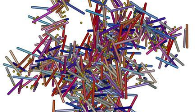Researchers enhance conductivity of polymeric composites
on

Physicists at the University of Luxembourg have developed a new method to improve the electrical conductivity of polymeric composites, which consist of two or more materials and are used in applications such as electrostatic screening in airplanes. The properties of composite materials can be improved by incorporating selected additives. For example, composite materials with conductive nanotubes added to increase electrical conductivity are used to improve the efficiency of flat-panel displays and solar cells.
The researchers in Luxembourg, in collaboration with scientists in the Netherlands, studied the electrical percolation of carbon nanotubes in a polymer matrix and showed that the percolation threshold – the point at which the polymer composite becomes conductive – can be lowered considerably if small amounts of a conductive polymer latex are added. The simulations for this research were done in Luxembourg, while the experiments took place at the Technical University of Eindhoven in the Netherlands.
According to project manager Prof. Tania Schilling at the University of Luxembourg, the aim of the project was to minimise the use of carbon nanotubes while retaining the benefit of their favourable properties. The research team discovered that they could achieve this goal by taking advantage of secondary interactions from additional additives. Finely dispersed (colloidal) particles of differing shapes and sizes mixed into the medium lead to the formation of systematic networks, which provide the basis for electrically conductivity in composites.
The latest findings of the materials scientists, resulting from the collaborative efforts of scientists at the University of Luxembourg, the Technical University of Eindhoven and the Dutch Polymer Institute, have been published in the peer-reviewed scientific journal Nature Nanotechnology.
Image: University of Luxembourg


Discussion (0 comments)